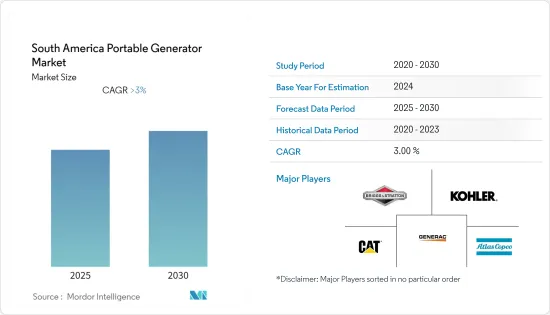 |
市场调查报告书
商品编码
1635479
南美可携式发电机:市场占有率分析、行业趋势和成长预测(2025-2030)South America Portable Generator - Market Share Analysis, Industry Trends & Statistics, Growth Forecasts (2025 - 2030) |
||||||
※ 本网页内容可能与最新版本有所差异。详细情况请与我们联繫。
预计南美洲可携式发电机市场在预测期内的复合年增长率将超过 3%。

COVID-19大流行对2020年市场产生了负面影响,减少了工业和商业部门的电力需求。
主要亮点
- 从长远来看,南美洲可携式发电机市场预计将由缺乏可靠的电网基础设施、对紧急备用电源解决方案的需求以及该地区一些偏远和农村地区新兴市场开发业务的增加推动成长。的推动,包括:
- 同时,对电池储存系统和其他清洁备用电力源的需求不断增长预计将抑制市场成长。
- 然而,南美地区新兴经济体的商业和工业部门、新兴经济体的住宅部门以及国防行动日益增长的电力需求将很快为市场参与企业创造巨大的商机。
- 由于对可靠电力的需求不断增加,巴西在该地区占据主导地位。
南美洲可携式发电机市场趋势
住宅领域预计将主导市场
- 随着发电机在每个家庭中越来越受欢迎,以确保紧急情况下的电力供应,可携式发电机市场的住宅部分预计将扩大并推动市场。
- 此外,南美洲对住宅能源的需求正在增加。根据 Empresa de Pesquisa Energetica(巴西能源研究办公室)的数据,2021 年住宅能源消费量比 2013 年的 124.91 兆瓦增加了约 149.8 兆瓦。然而,该地区的电力品质较差,这可能会推动可携式发电机市场的发展。
- 2022年1月,阿根廷首都布宜诺斯艾利斯酷暑超过摄氏40度,70万户家庭停电。
- 总体而言,南美洲不断增长的住宅电力需求和不断下降的电能品质可能会提振可携式发电机市场。
巴西可望主导市场
- 巴西是南美洲最大的国家之一,也是经济快速成长的国家之一。此外,巴西的电力主要依赖水力发电,其可靠性成为挑战。
- 截至 2021 年,水力发电约占总发电量的 55%(362.8TWh)。水力发电和需求中心之间的距离较长,造成了电力问题,并推动了可携式发电机市场的发展。
- 巴西政府也增加了基础设施的私人投资,特别是铁路、港口、高速公路和机场,以满足该国的需求。随着基础建设的进展,电力供需缺口将扩大,并支撑目标市场。
- 2021年,巴西经历了最严重的干旱。由于该国依赖水力发电,干旱威胁该国的电力供应。这一发展将对可携式发电机市场产生积极影响。
- 总体而言,该国对水力发电的依赖以及发电与需求之间不断扩大的差距支撑着可携式发电机市场。
南美洲可携式发电机产业概况
南美洲可携式发电机市场适度分散。该市场的主要企业(排名不分先后)包括 Generac Holdings Inc.、Caterpillar Inc.、Kohler Power Systems、Briggs &Stratton Corporation 和 Atlas Copco AB。
其他好处:
- Excel 格式的市场预测 (ME) 表
- 3 个月的分析师支持
目录
第一章简介
- 调查范围
- 市场定义
- 研究场所
第 2 章执行摘要
第三章调查方法
第四章市场概况
- 介绍
- 2027年之前的市场规模与需求预测(单位:十亿美元)
- 最新趋势和发展
- 政府法规政策
- 市场动态
- 促进因素
- 抑制因素
- 供应链分析
- 产业吸引力-波特五力分析
- 供应商的议价能力
- 消费者议价能力
- 新进入者的威胁
- 替代品的威胁
- 竞争公司之间敌对关係的强度
第五章市场区隔
- 按额定功率
- 小于5kW
- 5~10 kW
- 10kW以上
- 按燃料类型
- 气体
- 柴油引擎
- 其他燃料
- 按最终用户
- 产业
- 商业的
- 住宅
- 按地区
- 巴西
- 阿根廷
- 智利
- 南美洲其他地区
第六章 竞争状况
- 合併、收购、联盟和合资企业
- 主要企业策略
- 公司简介
- Generac Holdings Inc.
- Caterpillar Inc.
- Kohler Power Systems
- Briggs & Stratton Corporation
- Atlas Copco AB
第七章 市场机会及未来趋势
The South America Portable Generator Market is expected to register a CAGR of greater than 3% during the forecast period.

The COVID-19 pandemic negatively impacted the market in 2020, with reduced power demand in industrial and commercial sectors.
Key Highlights
- Over the long term, the South American portable generator market is expected to thrive due to various factors, such as the lack of reliable grid infrastructure, the need for emergency backup power solutions, and increasing development operations in several remote and rural areas in the region.
- On the other hand, increasing demand for battery storage systems and other cleaner sources of standby power is expected to restrain the market's growth.
- Nevertheless, the commercial and industrial sectors of emerging economies in the South American region, the residential sector of developing economies, and the increasing need for power in defense operations will create significant opportunities for market participants shortly.
- Brazil dominates the geographical segment as the country has an increased demand for reliable power.
South America Portable Generator Market Trends
Residential Segment Expected to Dominate the Market
- Because of the prevalent installation of gensets across households to ensure the availability of emergency power supply, the residential segment of the portable generators market is predicted to expand and drive the market.
- Further, South America has an increasing demand for residential energy. According to the Empresa de Pesquisa Energetica (Brazil's Energy Research Office), in 2021, residential energy consumption increased from 124.91 terawatt-hours in 2013 to about 149.8 terawatt-hours. However, the region has poor power quality, which could drive the market for portable generators.
- In January 2022, Argentina's capital, Buenos Aires, witnessed a power outage that left 700,000 households without electricity amid a heat wave with temperatures above 40 degrees Celsius.
- Overall, South America's increasing residential power demand and poor power quality would aid the portable generator market.
Brazil Expected to Dominate the Market
- Brazil, one of South America's largest countries, is among the fastest-growing economies. Furthermore, Brazil's national electricity reliability is challenged because it largely depends on hydropower.
- As of 2021, hydro energy constituted around 55% (362.8TWh) of the total generated power. The long-distance between hydropower generation and demand centers causes power issues which drives the portable generator market.
- The Brazilian government is also increasing private investment in infrastructure to meet the country's demand, especially in railways, ports, highways, and airports. The increasing infrastructure growth widens the power supply and demand gap, which aids the studied market.
- In 2021, Brazil witnessed the worst drought. The drought threatened the nation's electricity supply since the country is dependent on hydropower. Such instances positively affect the portable generator market, as it supports essential businesses and industries during such times.
- Overall, the country's dependence on hydropower and the widening gap between electricity generation and demand aid the portable generator market.
South America Portable Generator Industry Overview
The South American portable generator market is moderately fragmented. Some of the key players in this market (in no particular order) include Generac Holdings Inc., Caterpillar Inc., Kohler Power Systems, Briggs & Stratton Corporation, and Atlas Copco AB.
Additional Benefits:
- The market estimate (ME) sheet in Excel format
- 3 months of analyst support
TABLE OF CONTENTS
1 INTRODUCTION
- 1.1 Scope Of The Study
- 1.2 Market Definition
- 1.3 Study Assumptions
2 EXECUTIVE SUMMARY
3 RESEARCH METHODOLOGY
4 MARKET OVERVIEW
- 4.1 Introduction
- 4.2 Market Size And Demand Forecast In USD Billion, Till 2027
- 4.3 Recent Trends And Developments
- 4.4 Government Policies And Regulations
- 4.5 Market Dynamics
- 4.5.1 Drivers
- 4.5.2 Restraints
- 4.6 Supply Chain Analysis
- 4.7 Industry Attractiveness - Porter's Five Forces Analysis
- 4.7.1 Bargaining Power of Suppliers
- 4.7.2 Bargaining Power of Consumers
- 4.7.3 Threat of New Entrants
- 4.7.4 Threat of Substitute Products and Services
- 4.7.5 Intensity of Competitive Rivalry
5 MARKET SEGMENTATION
- 5.1 By Power Rating
- 5.1.1 Below 5 kW
- 5.1.2 5-10 kW
- 5.1.3 Above 10 kW
- 5.2 By Fuel Type
- 5.2.1 Gas
- 5.2.2 Diesel
- 5.2.3 Other Fuel Types
- 5.3 By End-user
- 5.3.1 Industrial
- 5.3.2 Commercial
- 5.3.3 Residential
- 5.4 By Geography
- 5.4.1 Brazil
- 5.4.2 Argentina
- 5.4.3 Chile
- 5.4.4 Rest of South America
6 COMPETITIVE LANDSCAPE
- 6.1 Mergers, Acquisitions, Collaboration And Joint Ventures
- 6.2 Strategies Adopted By Key Players
- 6.3 Company Profiles
- 6.3.1 Generac Holdings Inc.
- 6.3.2 Caterpillar Inc.
- 6.3.3 Kohler Power Systems
- 6.3.4 Briggs & Stratton Corporation
- 6.3.5 Atlas Copco AB











